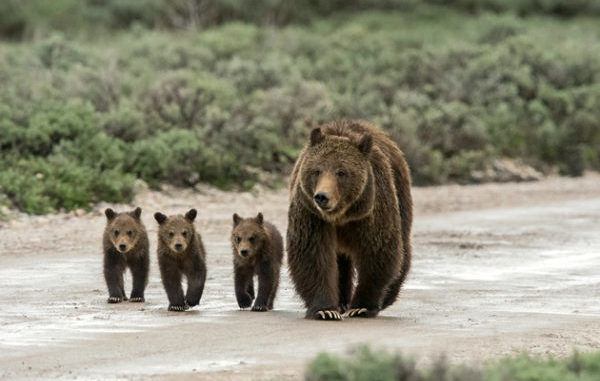
Colorado Parks and Wildlife has already received reports of bear activity in eight Colorado counties in 2020. With spring upon us, CPW reminds citizens that bears are emerging from their slumber and beginning their search for food.
Early season natural food sources for bears include grasses, aspen buds and other vegetative matter that is beginning to sprout. Those gentle food sources, which are the first crops available to them, help a bear’s digestive system and metabolism adjust back to normal after not consuming anything for months.
For the health and well-being of Colorado’s black bears, wildlife managers say bears should NOT be eating from trash receptacles, bird feeders or other human-provided food sources around homes.
“Every time a bear gets a treat, a bird feeder, a hummingbird feeder, trash, it teaches the bear that people mean food,” said Mark Lamb, CPW’s Area Wildlife Manager for South Park and the west Metro Denver area. “People who think that it’s one time, no big deal, are totally wrong. It is a big deal when you compound that ‘one time’ with how many ‘one time’ they get from your neighbors, too. It adds up.”
Some of the early season bear reports have been from simple sightings in Boulder and Morrison, to bears already getting into trash in Steamboat Springs and Silver Plume. Reports also include a bear getting into a vehicle in Snowmass Village, bears with livestock in Delta, and a bear vs. dog encounter under a deck in Colorado Springs.
Typically, male (boar) bears come out of hibernation first followed by females (sows) without cubs. Females that gave birth to cubs over winter in hibernation dens are the last to come out, usually in mid-to-late April.
Last year, CPW received 5,369 human-bear incident reports with nearly a third of those involving bears in trash. Wildlife managers are hoping to see a reduction in negative human-bear interactions across the state. However, that does not mean that people should stop reporting bear incidents to CPW. The earlier wildlife managers know of conflicts, the more tools they have to help keep small problems from growing into bigger and even dangerous scenarios.
“Our recommendations aren’t made to make our jobs easier,” explains Matt Yamashita, Area Wildlife Manager in Glenwood Springs. “What we’re asking is what is best for bears and for people. We don’t want to deprive people of seeing bears, but we want people to see a bear that doesn’t depend on humans for food.”
Bears are omnivores and primarily eat vegetation such as grasses, forbs, berries, acorns and seeds – food sources that span their waking seasons. But if natural food becomes scarce, or if human-provided food is easy to access, bears will begin looking in residential areas for their next meals.
Biologists are seeing bears that are shifting much of their life cycle toward communities. When a high-country berry bush yields a few hundred calories and a dumpster gives up thousands of calories via leftovers and greasy goodies, the bears will make the easy choice. Once they’ve made that choice they are instinctively trained by their stomachs to search out the easy option.
Lamb and Yamashita agree that bringing these large, territorial animals into areas with people is a recipe for human injury and bear death. While a nuisance bear getting into trash might be relocated if caught early, a bear that injures a person is put down.
“The bear is always the ultimate loser,” Lamb concludes.
“We have to do better as communities,” Yamashita urges.
Though most human-bear interactions occur in the late summer and fall months, a late frost or prolonged dry weather could lead to localized natural food failures, pushing black bears to be more persistent in their search for human-food sources. Being bear aware not only protects your home and property, but it can save a bear’s life.
Tips to prevent human/bear conflicts include:
- Keep garbage in a well-secured enclosure.
- Only put out garbage on the morning of pickup; bring empty cans back inside before dark.
- Use a bear-resistant trash can or dumpster. These are available online or from your trash hauler.
- Clean all garbage cans regularly to keep them odor free. The scent of ammonia can deter bears.
- Take down all bird feeders. Bird feeders are a major source of bear/human conflicts – 397 conflicts because of them in 2019 alone. Birds have naturally available food sources during the spring, summer and fall. Don’t let your bird feeder become a bear feeder.
- Don’t leave pet food or stock feed outside – never provide food sources for any wildlife.
- Clean all BBQ grills.
- Keep garage doors and windows closed and locked, especially between dusk and dawn.
- Don’t leave attractants such as snacks, food wrappers, gum, or even scented hand lotions in your car; and always lock vehicle doors.
- Use bear boxes or bear-proof containers for food and scented items when camping.
- Don’t leave food outside while camping. If bear boxes aren’t available, leave all food in the trunk of a locked vehicle as your last resort.
- Review CPW’s Bearproofing Your Home Fact Sheet and conduct a home audit to be sure you are not attracting bears to your property.
- Talk to your neighbors and kids about being bear aware.
For more information about Living with Bears in Colorado, visit https://cpw.state.co.us/bears.
Support Northern Colorado Journalism
Show your support for North Forty News by helping us produce more content. It's a kind and simple gesture that will help us continue to bring more content to you.
BONUS - Donors get a link in their receipt to sign up for our once-per-week instant text messaging alert. Get your e-copy of North Forty News the moment it is released!
Click to Donate
